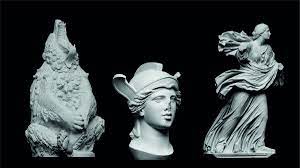Introduction
In the ever-evolving landscape of art, the fusion of technology and creative expression has birthed innovative mediums and methodologies. Among these, 3D printing stands out as a transformative force, offering artists unprecedented opportunities for sculptural exploration. This extensive article delves deeply into the captivating world of 3D printing in sculpture, navigating through diverse artistic projects, avant-garde techniques, and the expansive creative potential this revolutionary technology affords.
3D Printing in Sculpture: A Nexus of Art and Technology
Embracing the Realm of Artistic 3D Printing Projects
The amalgamation of artistry and 3D printing has birthed a spectrum of captivating projects that defy conventional sculptural norms. Artists, emboldened by the possibilities of this technology, are now able to breathe life into their visions with newfound precision and intricacy.
1. Organic Forms and Intricate Structures:
Leveraging the capabilities of 3D printing, artists craft organic, fluid forms and intricate structures that defy the limitations of traditional sculpting. This enables a level of detail and complexity that not only captivates but also redefines the boundaries of sculptural expression.
2. Interactive and Kinetic Sculptures:
The marriage of 3D printing and sculpture has given birth to interactive and kinetic artworks. These dynamic sculptures respond to external stimuli or viewer interaction, providing an immersive experience that transcends the static nature of traditional sculpture.
3. Customization and Personalization:
At the heart of 3D printing lies the ability to customize and personalize. Artists leverage this feature to tailor their sculptures to specific preferences, resulting in unique, personalized pieces that resonate on a deeply individual level.
Sculptural 3D Printing Techniques: Pushing Creative Boundaries
1. Layered Construction:
Traditional sculpting often involves carving from solid blocks, but 3D printing builds sculptures layer by layer. Artists capitalize on this technique to create intricate and textured surfaces, adding depth and nuance to their sculptural creations.
2. Support-Free Printing:
3D printing often necessitates support structures for complex designs. However, artists have pioneered techniques to minimize or eliminate the need for supports, allowing for more fluid and seamless sculptures that defy the constraints of traditional fabrication.
3. Multi-Material Printing:
The evolution of 3D printing technology has birthed the capability to print with multiple materials simultaneously. This breakthrough empowers artists to explore combinations of materials, resulting in sculptures with contrasting textures, colors, and even diverse material properties within a single piece.
4. Post-Processing Techniques:
Post-processing plays a pivotal role in sculptural 3D printing. Artists employ techniques such as sanding, polishing, and painting to refine the final appearance of their printed sculptures, elevating them to a level of finish comparable to traditional sculpting methods.
Fine Art with 3D Printing: A New Artistic Era
The integration of 3D printing into fine art has precipitated a paradigm shift, challenging established norms and introducing a new era of artistic exploration. This evolution is manifest in various aspects of the artistic process.
1. Digital Sculpting Platforms:
The creative journey often commences with digital sculpting using specialized software. This digital canvas allows for unparalleled precision and experimentation, laying the foundation for the final 3D-printed masterpiece.
2. Artistic Collaboration:
The collaborative potential of 3D printing is exemplified in projects where artists, engineers, and technologists converge. The intersection of diverse expertise results in artworks that seamlessly blend artistic vision with technical ingenuity, pushing the boundaries of achievable sculptural forms.
3. Exhibition and Recognition:
Major art institutions and galleries now prominently feature 3D-printed sculptures in exhibitions, recognizing their significance in the contemporary art landscape. This acknowledgment serves to legitimize 3D printing as a respected and integral medium within the realm of fine art.
Creative Uses of 3D Printing in Art: Beyond Sculpture
While 3D printing has found a natural home in sculptural art, its applications extend beyond the realm of traditional sculpture. Artists are exploring creative uses of 3D printing in various art forms, expanding the horizons of creative expression.
1. Wearable Art:
Beyond traditional sculpture, artists are crafting intricate jewelry and wearables through 3D printing. This dynamic fusion of art and fashion allows for the creation of lightweight, detailed pieces that redefine conventional design norms.
2. Installation Art:
The scalability of 3D printing is harnessed for large-scale installation art. Artists can now produce monumental structures that captivate audiences and transform spaces, exploring the interplay of form, light, and space on an unprecedented scale.
3. Hybrid Art Forms:
In a quest to bridge the tangible and the digital, some artists combine traditional sculpting techniques with 3D printing. The resulting hybrid art forms challenge preconceived notions, inviting viewers to reconsider the boundaries of artistic expression.
Conclusion
The symbiosis of 3D printing and sculpture represents not just an evolution but a revolution in the realm of art. From pushing the boundaries of traditional sculptural forms to exploring uncharted creative territories, artists are not merely embracing 3D printing; they are redefining the very essence of sculptural expression.
As technology continues to advance, the creative possibilities in sculptural 3D printing are poised to expand even further, challenging artists to unlock new realms of imagination and expression. This dynamic intersection of art and technology exemplifies the boundless potential of human creativity, and the journey has just begun. The world awaits the masterpieces yet to be conceived and brought to life through the transformative magic of 3D printing in sculpture.

